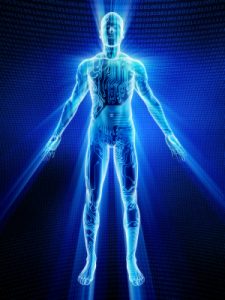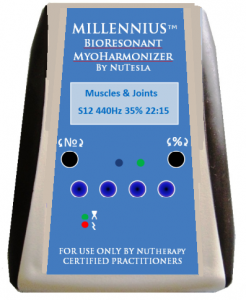 Rhythmedica is NuTesla’s patented technology to transcutaneously apply two simultaneous resonant frequencies for therapeutic purposes. The therapeutic application of resonant frequencies may be applied, but is not limited to, massage therapy and bodywork, acupuncture and acupressure, Functional Electrical Stimulation (FES) for Spinal Cord Injuries (SCI) and Central Nervous System (CNS) damage from strokes or external trauma, muscle strain and related injuries and post-operative joint replacement and related surgeries.
Rhythmedica is NuTesla’s patented technology to transcutaneously apply two simultaneous resonant frequencies for therapeutic purposes. The therapeutic application of resonant frequencies may be applied, but is not limited to, massage therapy and bodywork, acupuncture and acupressure, Functional Electrical Stimulation (FES) for Spinal Cord Injuries (SCI) and Central Nervous System (CNS) damage from strokes or external trauma, muscle strain and related injuries and post-operative joint replacement and related surgeries.
BACKGROUND
Over 200 years ago the Italian Galvani discovered electrical current caused muscle cells to contract. Since then electrical currents have been applied in numerous therapeutic applications and methods, and when applied to muscles they have been used to cause similar contractions. This use of electricity has been expanded to support adaptive neuroplasticity for spinal cord injury (SCI) and Central Nervous System (CNS) affected patients, such as stroke survivors. The most prevalent forms of this electrical stimulation are Transcutaneous Electrical Nerve Stimulators (TENS), which operates using short pulse durations designed to cause rapid muscle contractions, and Functional Electrical Stimulation (FES) which uses longer electrical pulse durations for SCI and CNS stimulation. While Millennius may be used in these types of applications, its method of operation is uniquely different as explained below.
 All organisms are energy systems comprised of interrelated organized atoms bound together by molecular electromagnetic forces. These atoms all have unique resonant frequencies caused by the rotation of electrons around a positively charged nucleus. Likewise, every molecule, cell and organ within any organism has its own resonant frequency. The resonant frequencies of those cells and organs can change and become out-of-balance as a result of injury, abuse or illness. Stimulating out-of-balance cells and organs with externally applied resonant frequencies can reveal instances of injury, abuse or illness. For example, Magnetic Resonance Imaging (MRI) relies upon the principle of atomic resonance in order to stimulate the targeted atoms within its imaging field to absorb and then release a burst of radio frequency energy tuned to the specific resonant frequency of the specific type of atom, usually hydrogen, within a given strength of a static magnetic field, thus supporting the concept of resonances in the organic systems. Rhythmedica aids the damaged tissues in their natural recovery by manipulation of their natural resonant frequencies. TENS and FES do not affect the resonant frequencies of the damaged tissue. Instead TENS treatments use short electrical pulses specifically to create muscle contractions, and FES uses a longer pulse duration to specifically aid SCI and CNS patients.
All organisms are energy systems comprised of interrelated organized atoms bound together by molecular electromagnetic forces. These atoms all have unique resonant frequencies caused by the rotation of electrons around a positively charged nucleus. Likewise, every molecule, cell and organ within any organism has its own resonant frequency. The resonant frequencies of those cells and organs can change and become out-of-balance as a result of injury, abuse or illness. Stimulating out-of-balance cells and organs with externally applied resonant frequencies can reveal instances of injury, abuse or illness. For example, Magnetic Resonance Imaging (MRI) relies upon the principle of atomic resonance in order to stimulate the targeted atoms within its imaging field to absorb and then release a burst of radio frequency energy tuned to the specific resonant frequency of the specific type of atom, usually hydrogen, within a given strength of a static magnetic field, thus supporting the concept of resonances in the organic systems. Rhythmedica aids the damaged tissues in their natural recovery by manipulation of their natural resonant frequencies. TENS and FES do not affect the resonant frequencies of the damaged tissue. Instead TENS treatments use short electrical pulses specifically to create muscle contractions, and FES uses a longer pulse duration to specifically aid SCI and CNS patients.
 Apparatuses for TENS treatment could possibly be used to affect the resonant frequencies of damaged tissue, but those designed to date have several qualities making such use unlikely and undesirable. First, the particular pulse frequency used must be based on natural healing frequencies, usually referred to as Rife frequencies. Second, the electrical pulses must be bipolar, rather than monopolar, such that standing scalar waves are created, as well as providing zero net current transfer. Third, the pulses of TENS devices are sufficiently strong to cause muscle contraction, an undesirable effect to achieve resonant frequency stimulation. Finally, there must be mixing of high and low frequency signals to allow for shorter duty cycles coupled with increased energy transfer efficiency.
Apparatuses for TENS treatment could possibly be used to affect the resonant frequencies of damaged tissue, but those designed to date have several qualities making such use unlikely and undesirable. First, the particular pulse frequency used must be based on natural healing frequencies, usually referred to as Rife frequencies. Second, the electrical pulses must be bipolar, rather than monopolar, such that standing scalar waves are created, as well as providing zero net current transfer. Third, the pulses of TENS devices are sufficiently strong to cause muscle contraction, an undesirable effect to achieve resonant frequency stimulation. Finally, there must be mixing of high and low frequency signals to allow for shorter duty cycles coupled with increased energy transfer efficiency.
RHYTHMEDICA IS THE ANSWER
 Instruments built on Rhythmedica’s patented technology address the above and other needs and provides means and systems for resonating the tissues of organisms using precise resonant frequencies, which are bipolar and have an zero net current with single phase energy of one to two orders of magnitude below that of traditional TENS units.
Instruments built on Rhythmedica’s patented technology address the above and other needs and provides means and systems for resonating the tissues of organisms using precise resonant frequencies, which are bipolar and have an zero net current with single phase energy of one to two orders of magnitude below that of traditional TENS units.
Generating the precise bio-resonant frequencies is achieved in Millennius through it’s patented waveform. In addition to creating its unique waveform, Rhythmedica causes the creation of standing electromagnetic waves, also known as scalar waves emitted. These scalar waves are created both within the Rhythmedica based instrument, and within the body of the connected mammal.
